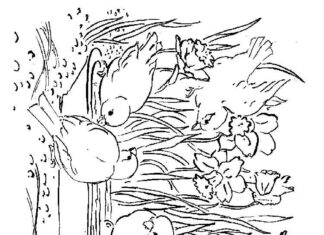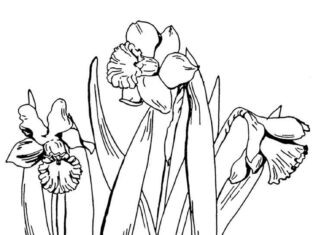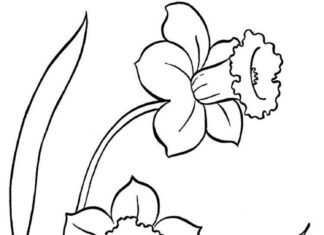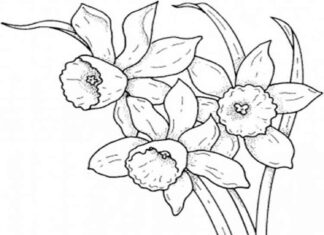Daffodil, also known as narcissus, is a bulbous plant in the amaryllis family. It is a popular ornamental plant that blooms in spring, displaying beautiful, trumpet-shaped flowers of various colors, such as white, yellow and orange. Daffodils are often associated with new life and rebirth, so they are a popular choice for spring gardens and flower bouquets. The plants are also known for their medicinal properties and are used in traditional medicine for various ailments.
Daffodil Coloring Pages
Information
- Types and varieties: There are many different species and varieties of daffodils, with different colors, sizes and shapes of flowers.
- Occurrence: Daffodils are native to Europe, northern Africa and western Asia, but are now grown all over the world.
- Flowering period: Daffodils usually bloom in the spring, although the exact time of flowering may vary depending on the region and variety.
- Growing conditions: Daffodils grow best in well-drained, fertile soil, in a sunny or semi-shaded position. Bulbs are planted in autumn.
- Application: Daffodils are often grown for their beautiful flowers, which are popular in bouquets and floral arrangements. They are also often planted in gardens, flowerbeds and lawns.
- Symbolism: The daffodil is a symbol of new life, rebirth and hope. It is a traditional symbol of spring and is often associated with Easter celebrations.
- Medicinal properties: Daffodils contain alkaloids that have medicinal properties. In the past, they have been used to treat various ailments such as coughs, colds and headaches. However, some parts of the plant are toxic and should not be eaten.
- Toxicity: All parts of the plant, especially the bulbs, are toxic to humans and animals. Ingestion can lead to symptoms such as nausea, vomiting, abdominal pain and diarrhea.
- Care: Daffodils require relatively little care. It is important that the soil is well-drained and that the plants get enough light. After flowering, it is recommended to remove the blooms, but the leaves should remain on the plant until they wither naturally.
- Reproduction: Daffodils are propagated by dividing the bulbs. Bulbs can be dug up after the end of the growing season, divided and replanted in the fall.
Trivia
- Origin of the name: The name "narcissus" comes from the mythological Narcissus, a young man of extraordinary beauty who fell in love with his reflection in water and turned into a flower.
- Different varieties: There are more than 50 species and thousands of varieties of daffodils, with different colors, shapes and sizes of flowers.
- Relationship to mythology: In Greek mythology, Narcissus was a flower that appeared on the spot where Narcissus turned into a plant. This flower had a sweet fragrance and was white with a red center.
- Alzheimer's drug: Galantamine, a drug used to treat mild to moderate cases of Alzheimer's disease, was originally extracted from the narcissus plant.
- First mentions: Daffodils were already known and cultivated in ancient Egypt and Greece. In ancient Greece, they were a symbol of death and associated with the underworld.
- National Collection: The UK has a National Collection of Narcissus, which includes more than 2,000 different varieties of daffodils.
- Narcissus Festival: Nantucket, Massachusetts, USA, hosts the annual Narcissus Festival, which features parades, gardening contests and other daffodil-related events.
- Application in poetry: William Wordsworth, a famous English poet, wrote a famous poem titled "I Wandered Lonely as a Cloud," in which he describes a field full of daffodils.
- Toxicity to animals: Daffodils are toxic to most pets, including dogs, cats and horses. Poisoning can lead to symptoms such as vomiting, diarrhea, convulsions and, in extreme cases, even death.
- Culture and folklore: In many cultures, daffodils are associated with spring and rebirth, but in some countries, such as Turkey, they are also a symbol of misfortune and bad luck.










